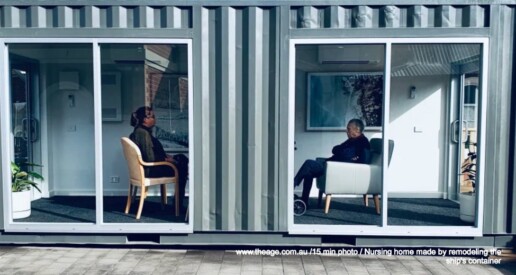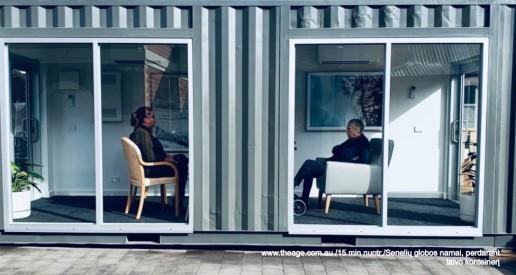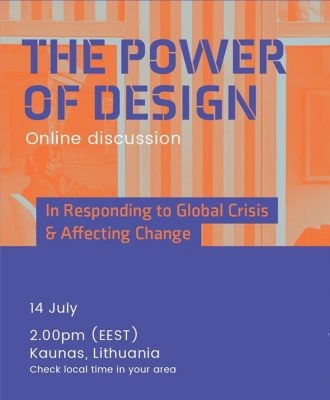Designers at the COVID-19 doorstep: the pandemic has caused fast and drastic life changes. How to “reboot” the world?
“Integrated design and its solutions create and shape our understanding of how a city and life in a city should look like. Form and content affect everything: economics, politics, culture. And the experience of quarantine, related with endless limitations, has provoked the need for urgent and creative solutions that not only make navigation in cities more convenient, facilitate the daily life of the new reality but also give us the opportunity to feel better,” said the participants of the last week’s discussion on design and its power to change the world.
Read more
Dizaineriai – prie COVID-19 slenksčio: pandemija lėmė greitus ir drastiškus gyvenimo būdo pokyčius. Kaip „perkrauti“ pasaulį?
„Susiliejęs į visumą dizainas ir jo sprendimai kuria ir formuoja mūsų suvokimą apie tai, kaip turi atrodyti miestas, gyvenimas mieste. Forma ir turinys veikia viską: ekonomiką, politiką, kultūrą. O karantino patirtis, susijusi su begale ribojimų, išprovokavo skubių ir kūrybiškų sprendimų poreikį, kurie ne tik padėtų patogiau naviguoti miestuose, palengvintų naujos realybės kasdienę buitį, bet ir suteiktų progą mums jaustis geriau“, – sako praėjusią savaitę vykusios diskusijos apie dizainą ir jo galią keisti pasaulį dalyviai.
Read more
Creative scenarios for saving the world – in a virtual “meeting” of the UNESCO Cities of Design
On the 14th of July at a convenient time for all the countries a virtual discussion “The Power of Design in Response to the Global Crisis and Rebooting the World” was broadcast from the “Kaunas – European Capital of Culture 2022” office. The participants of the discussion, presenting successful examples of pandemic-inspired creativity, were the representatives of the UNESCO Creative Cities of Design network, which encompasses 40 cities across the world – of course, including Kaunas. While observing the varied and always unexpected experiences it became obvious that design solutions are not only for aesthetic pleasure or just a symbol of luxury and status. They pave the way towards survival, drawing the world closer together and making it more comfortable for everyone.
After the quarantine forced museums, theatres and concert halls to close their doors, the representatives of Kaunas 2022 took it upon themselves to provide entertainment for the people forced to stay at home. The series of videos they provided was called “Culture at Home” and it involved dozens of Lithuanian artists, cultural operators and other people sharing information about the most interesting accessible cultural activities and the inexhaustible treasure trove of virtual or digitised content, and simply giving some advice on how to playfully get through this period. The next step of Kaunas 2022 was an unprecedented festival of “Culture at Home” which featured professional dancers, musicians and vocalists visiting numerous courtyards in Kaunas and Kaunas district and performing to the residents of surrounding houses in surprise concerts. Coincidentally or not, the culmination of this project lead to a distinctly unique celebration of Kaunas’ birthday – a celebration which shall be remembered for a very long time.
The cultural institutions of Kaunas were also determined to creatively utilise their resources during this crisis. The National Kaunas Drama Theatre conducted special virtual playbacks of the soundtracks of plays and discussions with people from the theatre and showed excerpts from historic plays. Due to the limited possibilities of serving their readers, the team of the Kaunas Municipal Vincas Kudirka library “employed” their 3D printer, which provided the frames for the protective shields for doctors, as well as innovative attachments to handles, allowing people to open doors with their elbows and eliminating unnecessary contact.
Turning a disadvantage into an advantage is a reliable way of fighting any crisis. When the citizens of the Belgian city of Kortrijk were instructed to avoid gatherings, work from home, etc., the creative city dwellers created a map of 150 secret spots where it was safe to spend time outside. From the best trees for climbing to the most breathtaking landscapes and former river beds – everybody could suggest their beloved places through a special website, and it looks like the map will live on even after the pandemic is under control. So far it has already been used by 20,000 people.
A retirement home in Geelong, Australia, much like other similar facilities around the world, was under strict quarantine during the pandemic. After all, it has been confirmed that the coronavirus is especially dangerous to the elderly. Still, although health is the most important thing, even the best internet connection and cameras are not a substitute for live communication, which is vital for the inhabitants of the nursing homes who miss their loved ones. So, what could
solve this problem? It did not take people long to find a solution. The establishment had an unused construction container which was transformed by a local construction worker into a meeting room with a glass wall and entrances from both ends. This solution was cheap (there was no need to hire an architect), and… it provided lots of joy to the inhabitants of the nursing home and their loved ones. The container even became a venue for birthday celebrations!
The media has been talking a lot about the Chinese city of Wuhan, which is a member of the UNESCO Creative Cities of Design network as well. Of course, most of the conversation involved the strict quarantine and the coronavirus rather than the creative ideas of the citizens. Still, all of these things are connected. When there was a shortage of beds for the infected, in mere 72 hours an unused exhibition centre was transformed into a comfortable hospital meeting all the safety regulations. The renovated building encompassing 22 square meters became a Noah’s Ark of sorts. During the month of its operation from the 3rd of February to the 8th of March, 1,760 patients were treated there.
The leitmotif of “a new point of view and the mobilisation of minds and resources” pervaded all the ideas presented during the virtual event. Montreal, Canada, decided to help local businesses and institutions adapt to the changes brought on by the quarantine. Special groups of designers and architects (as many as 57 of them) working together and apart were formed to take on requests, e.g. to provide a formerly non-existent outdoor area for a restaurant, or to tackle the issue of chaotic queues. Three groups are selected at random, they prepare initial proposals and the client selects the most convenient one. Simple, right?
An innovative way of celebrating when doing so is not allowed is to do it online. In May Helsinki relocated their traditional celebration from the “real” Senate Square in the city centre to the virtual reality, where the area and surrounding historic buildings were recreated. The celebration featured a performance by a popular musical band and the number of participants enjoying the show reached a million – much more than it would have in reality.
The video of the virtual discussion “The Power of Design in Response to the Global Crisis and Rebooting the World” can be found on the Kaunas 2022 social media platforms. Perhaps after looking into the creative and usually inexpensive but nevertheless effective solutions you will get some ideas of your own?




